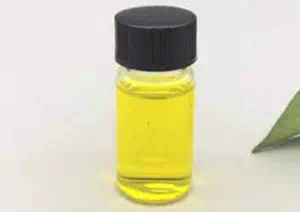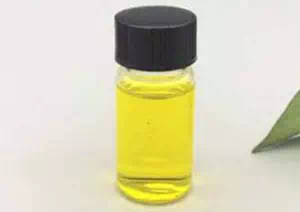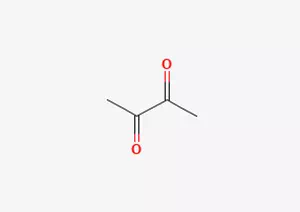All Categories



2-3-butanedione CAS 431-03-8, 2-3-butanedione, CAS 431-03-8
Diacetyl, also known as diacetyl, is a water-soluble volatile compound α -diketone compound with a buttery odor. It has a high vapor pressure at room temperature, evaporates quickly, has a melting point of -3 to -4℃, a boiling point of 87 to 88℃, and a flash point of 13℃.
CAS : 431-03-8
Formula : C4H6O2
Mol. wt. : 86.09
EINECS : 207-069-8
Chemical Name | 2,3-Butanedione |
Other Name | Butanedione; Diacetyl; Diacétyle |
CAS | 431-03-8 |
EINECS | 207-069-8 |
Type | Food additives; Flavor and Fragrance; Pharmaceutical, Pesticide and Dyestuff Intermediates |
Molecular Formula | C4H6O2 |
Molecular Weight | 86.09 |

Melting point | -4–2 °C |
Boiling point | 88 °C(lit.) |
density | 0.985 g/mL at 20 °C |
vapor density | 3 (vs air) |
vapor pressure | 52.2 mm Hg ( 20 °C) |
refractive index | n20/D 1.394(lit.) |
storage temp. | Store at +2°C to +8°C. |
solubility | 200g/l |
form | Liquid |
color | Clear yellow |
explosive limit | 2.4-13.0%(V) |
Odor Threshold | 0.00005ppm |
Water Solubility | 200 g/L (20 ºC) |
Stability | Stable. Flammable. Incompatible with acids, strong bases, metals, reducing agents, oxidizing agents. Protect from moisture and water. Note low flashpoint. |
Diacetyl, also known as diacetyl, is a water-soluble volatile compound α -diketone compound with a buttery odor. It has a high vapor pressure at room temperature, evaporates quickly, has a melting point of -3 to -4℃, a boiling point of 87 to 88℃, and a flash point of 13℃. It is readily soluble in ethanol, ether, most non-volatile oils and propylene glycol, and also soluble in glycerol and water, but insoluble in mineral oil.
Among natural products, diacetyl is present in laurel oil, ajawa oil, Angelica oil, raspberries, strawberries, cream, wine, etc. Due to its volatile nature, it mainly exists in primary fractions and distilled water. In addition, diacetyl is also a natural by-product of fermentation and exists in beer and wine. Meanwhile, it also exists in cigarette smoke.
Regarding the production methods of diacetyl, there are several ways to obtain this compound. One method is to convert 2-butanone into an isonitro compound and then conduct a hydrolysis reaction with hydrochloric acid to obtain diacetyl. Another production method is to oxidize 2-butanone on a copper catalyst at 300°C, or dehydrogenate 2, 3-butanediol on a copper or silver catalyst to synthesize diacetyl. In addition, diacetyl can also be synthesized through the acid-catalyzed condensation reaction of 1-hydroxyacetone with formaldehyde.
For the method of obtaining from naturally occurring diacetyl, it can be extracted from the starting fraction of the by-product of dairy fermentation. Although diacetyl itself is in liquid form, it can be converted into powder form by encapsulating it in solid materials to prevent evaporation. This powdered diacetyl can also be present in spray-dried seasonings.
It should be noted that although diacetyl is widely used as a flavor component in some foods and beverages, excessive intake may have negative effects on human health. Therefore, when using products containing diacetyl, the principle of moderation should be followed and it should be ensured that the products comply with relevant food safety standards.

GB2760-96 stipulates that edible flavorings are temporarily allowed to be used. The purpose of this regulation is to ensure that these flavorings can be legally and safely added during the production process of food to meet consumers' demands for different flavors.
2, 3-butanedione, as an important edible flavoring, is widely used in the preparation of various food flavorings. It is mainly used for the preparation of cream flavoring and is one of the main raw materials for the production of pyrazine flavoring. In addition to cream flavoring, 2, 3-butanedione can also be used in the flavoring of other foods such as milk and cheese, adding rich flavors to these foods.
In addition, 2, 3-butanedione is also used to make a variety of food flavorings with flavors such as berries, caramel, chocolate, coffee, cherries, vanilla beans, honey, cocoa, fruits, and wine. These flavorings not only enhance the taste and flavor of food, but also increase its appeal, meeting consumers' pursuit of diverse flavors.
Meanwhile, 2, 3-butanedione is also used in small amounts in fresh fruit essences or new cosmetic essences, adding unique aromas and flavors to these products.
It should be emphasized that although 2, 3-butanedione has extensive application value, it is still necessary to strictly abide by the requirements of relevant regulations and standards during its use to ensure the legality and safety of its application. At the same time, for any issue related to food safety, we should maintain a highly vigilant and responsible attitude to ensure that consumers' health and rights are not infringed upon.
* Prompt reply and 24 hours online, professional team to provide best price and high quality product.
* Sample testing support.
* Every batch of products will be tested to ensureits quality.
*The packing also can be according the customers` requirment.
*Any inquiries will be replied within 24 hours.
*we provide Commerical Invoice, Packing List, Bill of loading, COA , Health certificate and Origin certificate. If your markets have any special requirements, let us know.